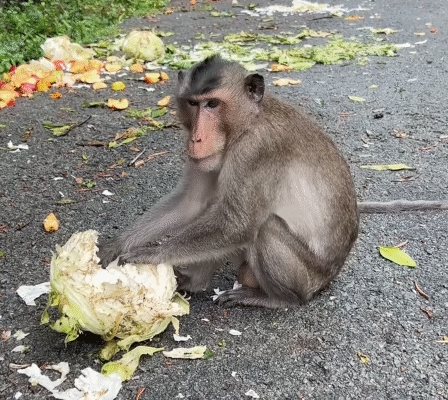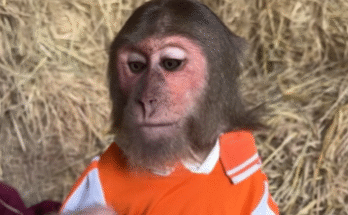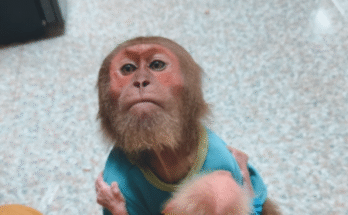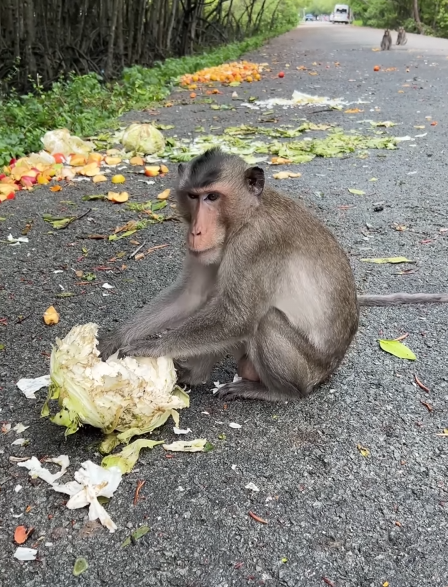
In the heart of a sun-dappled jungle, where sunlight streamed through the dense canopy and birds sang their morning songs, there lived a troop of mischievous monkeys known for their curiosity, intelligence, and unparalleled appetite for adventure. Among them, one little monkey stood out — a golden-furred, wide-eyed ball of energy who was as clever as he was cheeky. His name was Coco, and little did he know, today he was about to experience something that would have the entire jungle in stitches. Yes, Coco the monkey was about to be fed cabbage 🤣🐒.
It all began early one morning when the human caretakers who sometimes visited the jungle brought a large bundle of vegetables. There were carrots, sweet potatoes, bananas, and — oddly enough — a small head of cabbage. The monkeys were accustomed to fruits and occasional treats, but vegetables like cabbage were foreign, mysterious, and instantly intriguing. Coco, ever curious, scampered closer to inspect the new arrival. His nose twitched, his ears perked, and he tilted his head as he tried to make sense of the oddly round, leafy object.
At first, Coco sniffed the cabbage cautiously. He circled it, poked at it with tiny hands, and even tried giving it a tentative nibble. The taste, however, was not what he expected. The texture was firm, the flavor bland compared to the sweet bananas he adored, and the smell — well, it was strong enough to make his little nose wrinkle. Coco paused, blinked, and then looked up at the humans with a questioning squeak, as if to say, “Are you serious? This is supposed to be food?”
The other monkeys watched with fascination. Coco, being the ringleader of the troop, had set the standard for how to react to new experiences. His confused expressions and exaggerated gestures had everyone intrigued. Some younger monkeys tentatively approached the cabbage, inspired by Coco’s curiosity, only to recoil as soon as they tasted a piece. The adults, more cautious, hung back, observing the entire scene with quiet amusement.
Seeing Coco’s initial hesitation, one of the humans decided to encourage him with a playful gesture. They held a piece of cabbage up and waved it gently. Coco, never one to back down from a challenge, leapt toward it with gusto — only to grab it clumsily and drop it immediately. The cabbage landed with a soft thud, rolled slightly, and Coco stared at it like it had personally betrayed him. Then, in a moment of sheer theatrical frustration, he tossed it into the air, only for it to land on his head.
The troop erupted in squeals of laughter — yes, monkeys laugh too, in their own way. Coco shook his head vigorously, trying to dislodge the leafy helmet, and chattered furiously, making it clear that he was neither pleased nor impressed. But Coco was also a clever monkey, and he quickly realized that this cabbage could be turned to his advantage in ways beyond eating.
With a mischievous gleam in his eyes, Coco began to use the cabbage as a toy. He rolled it down a gentle slope, chased after it, and even tried to hide it under leaves as if he were stashing a treasure. The younger monkeys, inspired by his antics, joined in, and soon the entire troop was engaged in a chaotic cabbage game. They tossed, rolled, and wrestled over the leafy vegetable, squealing and leaping in every direction. Coco, of course, was at the center of it all, directing the action with playful shouts and dramatic gestures.

At one point, Coco attempted what could only be described as a “cabbage stunt.” He climbed to the top of a low branch, balanced carefully, and tried to launch the cabbage toward a nearby monkey. The trajectory was… less than perfect. Instead of landing on his target, the cabbage swung wildly, hit a branch, and bounced straight onto Coco’s own face. He tumbled backward, landing softly in a pile of leaves, while the rest of the troop squealed with laughter. Coco sat up, shaking the cabbage from his head and glaring at it with mock indignation, as if it had personally plotted against him.
The humans watching could barely contain their laughter. Coco’s expressions, his frantic movements, and his dramatic reactions made for a scene worthy of a cartoon. They realized that this seemingly simple act of feeding a monkey cabbage had turned into one of the funniest jungle moments they had witnessed. Coco, oblivious to the audience’s amusement, continued his antics, determined to assert control over this strange new vegetable.
As the day progressed, Coco’s relationship with the cabbage evolved. Initially skeptical and frustrated, he gradually began to experiment with it. He discovered that he could peel some of the leaves and toss them in the air, creating a leafy shower that delighted the younger monkeys. He also found that rolling the cabbage across branches could be an effective way to distract others and grab attention. By the afternoon, the cabbage was less of a food item and more of a prop in Coco’s daily adventures.
Other monkeys in the troop, inspired by Coco, began experimenting as well. Some tried eating it again, realizing that while it wasn’t as sweet as bananas, it could be chewed and manipulated in amusing ways. Others used it in playful tricks — hiding it, tossing it, or pretending it was a ball. The jungle, once a quiet scene of morning foraging, had transformed into a stage for one of the funniest games of the season. Coco, of course, remained the star of the show, squeaking with delight every time his cabbage stunts succeeded.
By late afternoon, the cabbage had undergone countless transformations: it had been a hat, a toy, a projectile, and even a makeshift drum as Coco banged it on the ground. His ingenuity, energy, and sense of humor had turned what could have been a mundane vegetable into a source of endless entertainment. The troop followed his lead, squeaking, leaping, and tumbling in laughter — and even Coco, tired but triumphant, seemed to enjoy his new favorite prop.
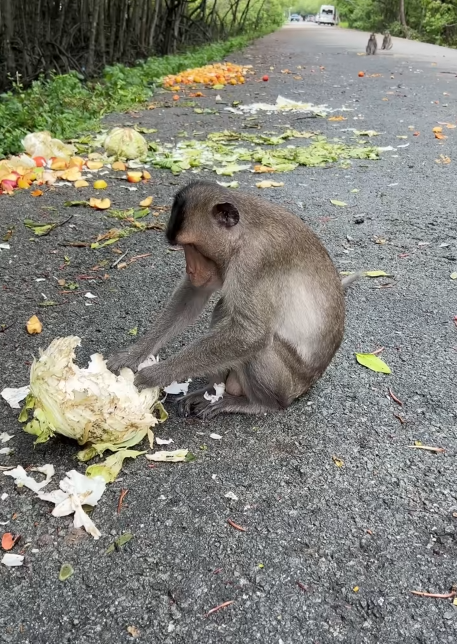
Finally, as the sun began to set and the jungle’s golden light filtered through the leaves, Coco sat atop a sturdy branch with the cabbage next to him. He inspected it carefully, as if acknowledging that while he may not have enjoyed eating it initially, it had provided him with the best day of mischief and play he had had in a long time. His expression was one of satisfied pride: he had turned a confusing, frustrating situation into a hilarious adventure.
Watching Coco, it became clear that the jungle was a place where creativity, humor, and intelligence thrived. A simple cabbage, when introduced to the right monkey, could become a source of endless laughter and amusement. Coco had shown that adaptability, cleverness, and a playful attitude could turn even the most mundane situations into unforgettable moments.
The humans, the rest of the troop, and even the jungle itself seemed to share in the laughter. Coco’s antics were a reminder that life, even in the wild, is best approached with curiosity, creativity, and a sense of humor. He had been fed cabbage — something he didn’t particularly like — yet he had transformed it into a source of joy, play, and hilarity.
As night fell and the troop settled into their nests, Coco curled up next to the now slightly tattered cabbage. It had been a day full of chaos, laughter, and unforgettable moments. The cabbage had started as a strange, unfamiliar object and ended as the centerpiece of one of the funniest days in the jungle. Coco, golden-furred and wide-eyed, had emerged victorious, entertained, and completely exhausted.
And so, the story spread through the jungle: Coco, the clever monkey who turned a cabbage into comedy gold, had shown everyone that even the most unexpected situations could lead to laughter, mischief, and fun.
The moral of the story? The monkey was fed cabbage 🤣🐒 — and the jungle has never stopped laughing since!
